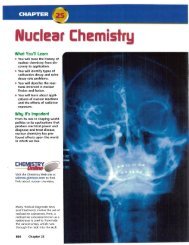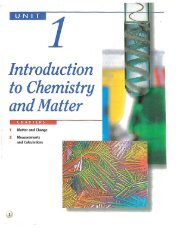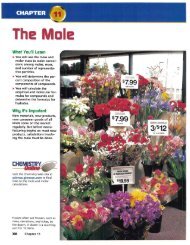Solutions
Solutions
Solutions
Create successful ePaper yourself
Turn your PDF publications into a flip-book with our unique Google optimized e-Paper software.
~HAPTER __ ASSESSMENT<br />
[HE<br />
Go to the Chemistry Web site at<br />
science.glencoe.com or use the Chemistry<br />
CD-ROM for additional Chapter 15 Assessment.<br />
Concept Mapping-----<br />
47. Complete the following concept map using the following<br />
terms: molarity, mole fraction, molality, moles of<br />
solute.<br />
1.<br />
volum! I ~tal moles<br />
of solution in solution<br />
/ Kilograms ""<br />
2 of solvent 4<br />
-~ I .<br />
3.<br />
Mastering Concepts-----<br />
48. What is the difference between solute and solvent<br />
(15.1)<br />
49. What determines whether a solute will be soluble in a<br />
given solvent (15.1)<br />
50. Explain the difference between saturated and unsaturated<br />
solutions. (15.1)<br />
51. What does it mean if two liquids are said to be miscible<br />
(15.1)<br />
52. What are three ways to increase the rate of solvation<br />
(15.1)<br />
53. Why are gases less soluble at higher temperatures<br />
(15.1)<br />
54. What is the difference between percent by mas~ and<br />
percent by volume (15.2)<br />
55. What is the difference between molarity and molality<br />
(15.2)<br />
56. Explain on a particle basis why the vapor pressure of a<br />
solution is lower than a pure solvent. (15.3)<br />
57. How does a solute affect the boiling point of a solution<br />
(15.3)<br />
58. How does a solute affect the freezing point of a solution<br />
(15.3)<br />
59. Describe osmosis. (15.4)<br />
60. What is a colligative property (15.4)<br />
61. What is a suspension and how does it differ from a<br />
colloid (15.4)<br />
62. Name a colloid formed from a gas dispersed in a liquid.<br />
(15.4)<br />
63. How can the Tyndall effect be used to distinguish<br />
between a colloid and a solution Why (15.4)<br />
Mastering Problems----<br />
Henry's Law (15.1)<br />
64. The solubility of a gas in water is 0.22 gIL at 20.0 kPa<br />
of pressure. What is the solubility when the pressure is<br />
increased to 115 kPa<br />
65. The solubility of a gas in water is 0.66 gIL at 15 kPa<br />
of pressure. What is the solubility when the pressure is<br />
increased to 40.0 kPa<br />
66. The solubility of a gas is 2.0 gIL at 50.0 kPa of pressure.<br />
How much gas will dissolve in 1 L at a pressure<br />
of 10.0 kPa<br />
67. The solubility of a gas is 4.5 gIL at a pressure of<br />
1.0 atm. At what pressure will there be 45 g of gas in<br />
1.0 L of solution<br />
68. The partial pressure of CO 2 inside a bottle of soft drink<br />
is 4.0 atm at 25°C. The solubility of CO 2 is 0.12 mollL.<br />
When the bottle is opened, the partial pressure drops to<br />
3.0 X 10- 4 atm. What is the solubility of CO 2 in the<br />
open drink Express your answer in grams per liter.<br />
Percent <strong>Solutions</strong> (15.2)<br />
69. Calculate the percent by mass of 3.55 g NaCl dissolved<br />
in 88 g water.<br />
70. Calculate the percent by mass of benzene in a solution<br />
containing 14.2 g of benzene in 28.0 g of carbon tetrachloride.<br />
71. What is the percent by volume of 25 mL of methanol<br />
in 75 mL of water<br />
72. A solution is made by adding 1.23 mol KCl to<br />
1000.0 g of water. What is the percent by mass of<br />
KCl in this solution<br />
73. What mass of water must be added to 255.0 g NaCl to<br />
make a 15.00 percent by mass aqueous solution<br />
74. The label on a 250-mL stock bottle reads "21.5% alcohol<br />
by volume." What volume of alcohol does it<br />
contain<br />
75. A 14.0 percent by mass solution of potassium iodide<br />
dissolved in water has a density of 1.208 g/mL. How<br />
many grams of K1 are in 25.0 mL of the solution<br />
484 Chapter 15 <strong>Solutions</strong>












